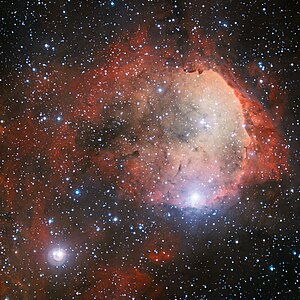NGC 3324
 | |
| Aufnahme des 2,2-m-ESO-WFI-Teleskops | |
| AladinLite | |
| Sternbild | Kiel des Schiffs |
| Position Äquinoktium: J2000.0 | |
|---|---|
| Rektaszension | 10h 37m 16,2s [1] |
| Deklination | -58° 37′ 10″ [1] |
| Erscheinungsbild | |
| Helligkeit (visuell) | 6,7 mag [2] |
| Helligkeit (B-Band) | 6,9 mag |
| Winkelausdehnung | 16,0' × 14,0' [2] |
| Rötung (Farbexzess E(B-V)) | 0,48 ± 0,03 |
| Physikalische Daten | |
| Zugehörigkeit | Milchstraße, Carina-Komplex |
| Rotverschiebung | −0,000028 |
| Radialgeschwindigkeit | −8,5 km/s |
| Entfernung [3] | 7550 Lj (2317 pc) |
| Geschichte | |
| Entdeckt von | James Dunlop |
| Entdeckungszeit | 1. Mai 1826 |
| Katalogbezeichnungen | |
| NGC 3324 • C 1035-583 • OCl 819 • Cr 225 • ESO 128-EN006 • GC 2167 • h 3286 • | |
NGC 3324 ist ein Emissionsnebel mit einem wahrscheinlich sehr jungen offenen Sternhaufen im Nordwesten des Carinanebels, welcher mit dem Emissionsnebel IC 2599 eng verbunden ist. Die Entfernung wird auf 7500 Lichtjahre geschätzt; der Winkeldurchmesser beträgt etwa 15'. Er wurde am 1. Mai 1826 von James Dunlop entdeckt.[4]
Detailstudie des Hubble-Weltraumteleskops
Detailstudie des James-Webb-Weltraumteleskops (eine der ersten Aufnahmen des Teleskops)
Weblinks
- Space Telescope Science Institute: NASA’s Webb Reveals Cosmic Cliffs, Glittering Landscape of Star Birth (12. Juli 2022)
- SIMBAD NGC 3324
- ESO: Sternentstehungs-Höhle mit Profil (+Fotos, Karte & Animation) 1. Februar 2012
Einzelnachweise
Auf dieser Seite verwendete Medien
Autor/Urheber: ESO, Lizenz: CC BY 4.0
The Wide Field Imager on the MPG/ESO 2.2-metre telescope at the La Silla Observatory has imaged a region of star formation called NGC 3324. The intense radiation from several of NGC 3324's massive, blue-white stars has carved out a cavity in the surrounding gas and dust. The ultraviolet radiation from these young hot stars also cause the gas cloud to glow in rich colours.
This month's three-dimensional-looking Hubble image shows the edge of the giant gaseous cavity within the star-forming region called NGC 3324. The glowing nebula has been carved out by intense ultraviolet radiation and stellar winds from several hot, young stars. A cluster of extremely massive stars, located well outside this image in the center of the nebula, is responsible for the ionization of the nebula and excavation of the cavity.
The image also reveals dramatic dark towers of cool gas and dust that rise above the glowing wall of gas. The dense gas at the top resists the blistering ultraviolet radiation from the central stars, and creates a tower that points in the direction of the energy flow. The high-energy radiation blazing out from the hot, young stars in NGC 3324 is sculpting the wall of the nebula by slowly eroding it away.
Located in the Southern Hemisphere, NGC 3324 is at the northwest corner of the Carina Nebula (NGC 3372), home of the Keyhole Nebula and the active, outbursting star Eta Carinae. The entire Carina Nebula complex is located at a distance of roughly 7,200 light-years, and lies in the constellation Carina.
This image is a composite of data taken with two of Hubble's science instruments. Data taken with the Advanced Camera for Surveys (ACS) in 2006 isolated light emitted by hydrogen. More recent data, taken in 2008 with the Wide Field Planetary Camera 2 (WFPC2), isolated light emitted by sulfur and oxygen gas. To create a color composite, the data from the sulfur filter are represented by red, from the oxygen filter by blue, and from the hydrogen filter by green.What looks much like craggy mountains on a moonlit evening is actually the edge of a nearby, young, star-forming region NGC 3324 in the Carina Nebula. Captured in infrared light by the Near-Infrared Camera (NIRCam) on NASA’s James Webb Space Telescope, this image reveals previously obscured areas of star birth.
Called the Cosmic Cliffs, the region is actually the edge of a gigantic, gaseous cavity within NGC 3324, roughly 7,600 light-years away. The cavernous area has been carved from the nebula by the intense ultraviolet radiation and stellar winds from extremely massive, hot, young stars located in the center of the bubble, above the area shown in this image. The high-energy radiation from these stars is sculpting the nebula’s wall by slowly eroding it away.
NIRCam – with its crisp resolution and unparalleled sensitivity – unveils hundreds of previously hidden stars, and even numerous background galaxies. Several prominent features in this image are described below.
-- The “steam” that appears to rise from the celestial “mountains” is actually hot, ionized gas and hot dust streaming away from the nebula due to intense, ultraviolet radiation.
-- Dramatic pillars rise above the glowing wall of gas, resisting the blistering ultraviolet radiation from the young stars.
-- Bubbles and cavities are being blown by the intense radiation and stellar winds of newborn stars.
-- Protostellar jets and outflows, which appear in gold, shoot from dust-enshrouded, nascent stars.
-- A “blow-out” erupts at the top-center of the ridge, spewing gas and dust into the interstellar medium.
-- An unusual “arch” appears, looking like a bent-over cylinder.
This period of very early star formation is difficult to capture because, for an individual star, it lasts only about 50,000 to 100,000 years – but Webb’s extreme sensitivity and exquisite spatial resolution have chronicled this rare event.
Located roughly 7,600 light-years away, NGC 3324 was first catalogued by James Dunlop in 1826. Visible from the Southern Hemisphere, it is located at the northwest corner of the Carina Nebula (NGC 3372), which resides in the constellation Carina. The Carina Nebula is home to the Keyhole Nebula and the active, unstable supergiant star called Eta Carinae.
NIRCam was built by a team at the University of Arizona and Lockheed Martin’s Advanced Technology Center.



